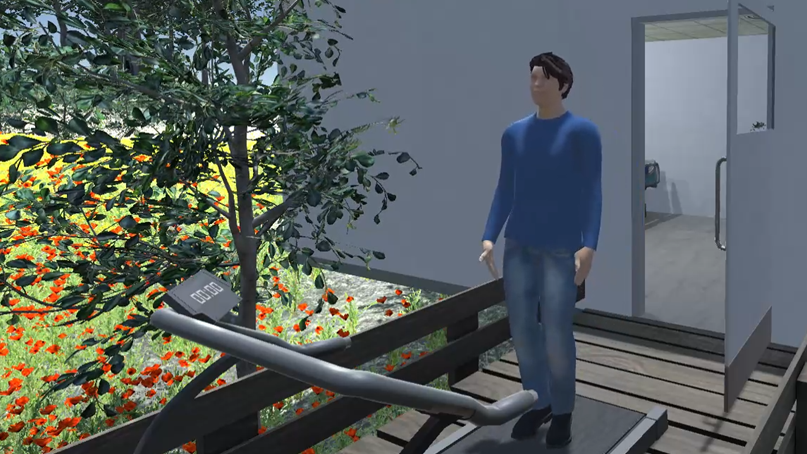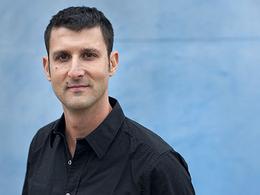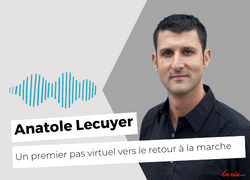
It all started with a conversation. An informal chat between Yoann Launey, anesthesiologist at the Rennes University Hospital, and Anatole Lécuyer, head of Hybrid, an Inria team at the forefront of virtual reality research. The gist was that after hospitalization in Intensive Care Units (ICUs), nearly half the patients develop ICU-acquired weakness. Mainly caused by immobilization and ICU treatments, this neuromuscular disorder delays the return to walking and the discharge from hospital. In the course of the discussion, an idea cropped up. Why not offer patients coming out of Intensive Care a Virtual Reality experience through which they could observe their avatar walking ? The feeling of immersion might activate the sense of agency, stimulate the sensory-motor system and thus favor faster recovery.
An interesting hypothesis indeed. But rather challenging to validate as it calls for complex experimental protocols. So the idea was just kept on the back burner at the time. Then Covid broke out. Thousands people sedated and placed under mechanical ventilation in ICUs. Thousands then transferred to rapidly overwhelmed rehabilitation wards. Hospital saturation. State of emergency.

Verbatim
At which point, we said: let's go! . A group of 18 persons volunteered to devise a protocol and build an application from scratch, leveraging all the know-how accumulated by our team over many years. Locked down at home, each one would develop their piece of code. Two months later the application was up and running. Deployment and clinical trials at the University Hospital could start.
Chercheur Inria et responsable de l'équipe-projet Hybrid
The project was called VERARE. It became part of Inria’s nationwide initiative to swiftly come up with a string of digital tools that could help mitigate the pandemic.
Two Criteria For Inclusion
The cohort includes around 50 patients. “The group had to be as homogeneous as possible so that the patients’ recovery profiles would be comparable, says Mélanie Cogné, a doctor in Physical and Rehabilitation Medicine at the University Hospital, and also a member of Hybrid. So we selected two criteria for inclusion. First: all patients had to present severe ICU-acquired weakness resulting from several weeks or even several months in Intensive Care Unit. Second: this feebleness had to be consecutive to a severe infection that originally motivated admission to ICU.”
In practical terms, the VR apparatus is made of a headmounted display and a computer on a hospital cart
Verbatim
It’s very handy. Sessions are held for 9 days on the basis of 10 minutes each. At the outset, the patients start seeing themselves embodied in an avatar sitting in a hospital room that resembles their own. Then, they see their avatar walking outdoor. This walk lasts 9 minutes, across a nice virtual forest or beach, at the end of which the patients will seat on a virtual deckchair and relax for an additional one minute. The purpose here is to transition smoothly and avoid leaving the VR environment abruptly. At the beginning, we were not sure that this activity wouldn’t disturb the patients given their state of tiredness. But it doesn’t seem to be the case. They rather appreciate these sessions.
Médecin au CHU en médecine physique et de réadaptation, membre de l’équipe-projet Hybrid
Avoiding Experimental Bias
In order to assess the benefits of this VR stimulation, one must be able to compare the recovery of patients who attended these sessions against the recovery of other patients who did not. This is commonly called a control group. But a problem pops up. “The mere fact of wearing a head mounted display, participating to an activity or receiving attention from the nursing staff may have a beneficial effect in and of itself, thus introducing an experimental bias. Therefore, one must make sure that a better recovery really results from observing the walk of the avatar and not something else. That’s why the people from the control group were offered a VR experience as well. They got to practice 10 minutes of relaxation on the virtual deckchair.”
Parallel to this clinical research which, by definition, is very time consuming, runs a second and much faster track. “In our lab, at Inria, we are testing the next technological upgrades of this system, Lécuyer explains. The goal is to collect more data, in particular in terms of leg motion, but also to add tactile features to the VR gear.” Participants to these experiments are not postcoma patients but volunteers recruited in the lab. In a matter of months, this second track led to three publications in IEEE Transactions on Visualization and Computer Graphics, the flagship journal in the VR field.
Underfoot Vibrotactile Feedback
“The first one was about the influence of user posture during VR observation. Does the fact the user is lying on a bed, seated in a semi-sitting position, or standing, change the sensation of walking? The study shows that the sense of agency is higher when one is sitting or standing compared to when one is lying. We also tested different locomotion exercises. Is the sensation any different when the user observes the avatar walking, jogging or stepping over virtual obstacles? The results suggest that the sense of agency can be elicited in all cases !”
In the second paper, scientists investigated “how underfoot vibrotactile feedback can increase the impression of walking. We have designed and tested innovative underfoot vibrations, showing that the tactile rendering does indeed raise such impression. Which is a very promising finding.”
The third article introduced physiological mechanisms meantto increase the effort sensation. “We designed a highly original abdominal belt that compresses the body and simulates faster breathing. A view of exhalation is also displayed in the scene during physical exertion and participants get to hear the sound of rapid breathing as well. This is strongly and significantly increasing the sensation of effort and walking at low cost.”
In the meantime, the project keeps growing. “It was started with just a post-doc and a trainee. Then we decided to devote a PhD thesis to the topic, enrolling a student from computer background. And we are now about to begin a second PhD thesis with a medical doctor whose MD was about VERARE. So one PhD work will delve more into technology whereas the other one will focus on transposing it to the medical context.”
Recapping the whole sequence of events, Lécuyer sums up: “We built an ambitious application from scratch in record time, got it deployed it in the hospital right away, sparked a very original line of research, published three major articles and launched two PhD theses.”
But what about the clinical findings? “Due to ethical reasons, we can’t disclose any result at this stage since the inclusion is not completed. Then, the data analysis will also take a while. As usual with clinical research, we have to be patient…” And this will likely result in yet another major publication…

Know more about Verare with Anatole Lécuyer (french)
Find the Verare project at the 2023 edition of Laval Virtual
Laval Virtual - 12th to 14th of April, 2023 - Espace Mayenne, 2 Rue Joséphine Baker , 53000 Laval
On the Destination Rennes stand (Hall A, stand A86), Inria presents the research work of the HYBRID project-team, which is interested in creating new techniques for interacting with virtual environments, by exploiting both the user's motor activity (motion capture) and mental activity (brain-computer interfaces). The applications of their research program concern the industrial field (virtual prototyping), medicine (surgical simulators, rehabilitation and rehabilitation), design (architectural models), digital art, 3D applications on the Web, or even games. video and entertainment.